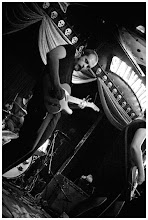We just finished listening to Autolux's album Future Perfect as a reference point for our album. That got me excited, as the Autolux record is one of my favorite sounding records of the last decade. Now we're listening to our opening track, "This Would Be The Time" and Christian is playing the last minute and half over and over while tweaking all sorts of compression and EQ knobs. First he makes the record sound like we're listening to it through a line of string and a tin can. More knobs twist. Now the record sounds like it's underwater, with huge bass swoons and swells. Then he cuts the bass all together and the mids shine through like glaring sunlight through clouds on a hangover morning.
A rapid succession of clicks as if he is trying 15 different channels ensues, a slight pop like a needle skipping separating each one. A quick check on our reference. Silence. He switches some more knobs. He says he's having trouble matching the kick in our recording to the level of that in the Autolux. Perhaps Autolux is not the best reference?
We listen to Built To Spill. Still no match. Christian is of the opinion that we need to bring the kick up in the mixes. It's a sobering statement, one whose implication could throw a serious monkey wrench in this whole business. Going backwards to the mixing stage is the last thing in the world I want to do, but listening to other recordings, Christian has a valid point. In order to make the record sound as big as possible, the man needs more kick.
Oh, the mysteries of mastering, if only you'd remained as such.




No comments:
Post a Comment